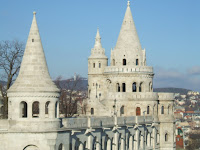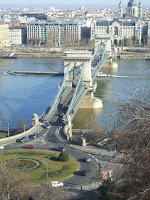 We spent a sunny morning in the Royal Castle District. Chilly, but sunny. Perfect for taking gorgeous photos and enjoying the clear panorama opened up focusing the other side of Duna including the Parlament. After we became a bit exhausted and a bit frozen through, we looked up the „StrudelCastle” where we could get not only fine strudels but also so-called bread-scone either salami or bacon on top. Hot tea was indispensible of course in order we can fill up suitably for the rest of our walking tour.
We spent a sunny morning in the Royal Castle District. Chilly, but sunny. Perfect for taking gorgeous photos and enjoying the clear panorama opened up focusing the other side of Duna including the Parlament. After we became a bit exhausted and a bit frozen through, we looked up the „StrudelCastle” where we could get not only fine strudels but also so-called bread-scone either salami or bacon on top. Hot tea was indispensible of course in order we can fill up suitably for the rest of our walking tour.Some famous spots without aiming at completeness, in pictures and in some words: 

 Halászbástya / Fisherman’s Bastion is a terrace in neo-Gothic and neo-Romanesque style situated o
Halászbástya / Fisherman’s Bastion is a terrace in neo-Gothic and neo-Romanesque style situated o n the Buda bank of the Danube around Matthias Church. It was designed and built between 1895 and 1902 on the plans of Frigyes Schulek. Its seven towers represent the seven Hungarian tribes that settled in the Carpathian Basin in 896. The Bastion takes its name from the guild of fishermen that was responsible for defending this stretch of the city walls in the Middle Ages. It is a viewing terrace with many stairs and walking paths.
n the Buda bank of the Danube around Matthias Church. It was designed and built between 1895 and 1902 on the plans of Frigyes Schulek. Its seven towers represent the seven Hungarian tribes that settled in the Carpathian Basin in 896. The Bastion takes its name from the guild of fishermen that was responsible for defending this stretch of the city walls in the Middle Ages. It is a viewing terrace with many stairs and walking paths. 



0 comments:
Post a Comment